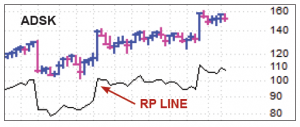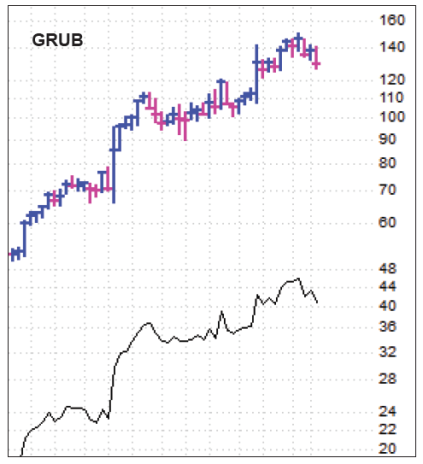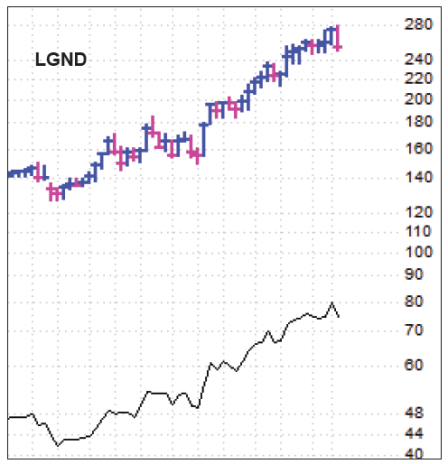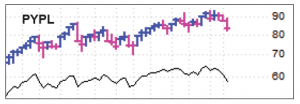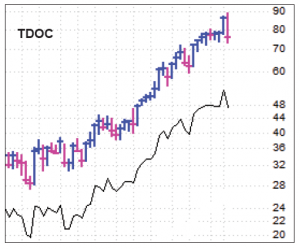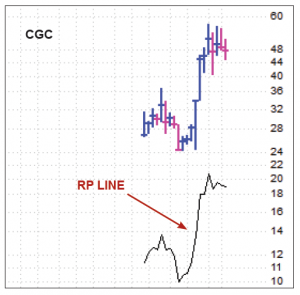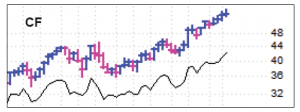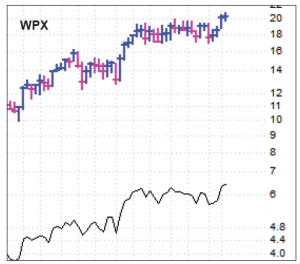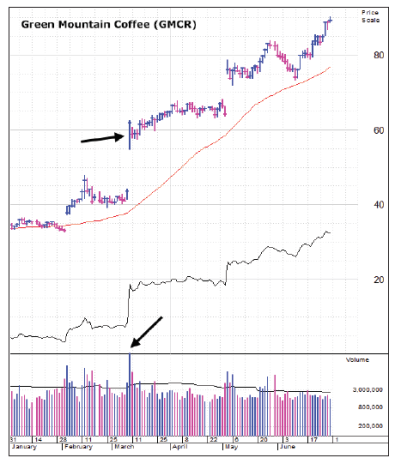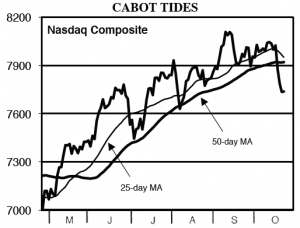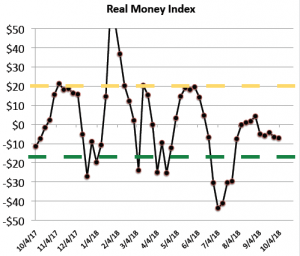Growth stocks have gone over the cliff during the past eight trading days, with many suffering waterfall-like declines. With our Tides negative and most growth stocks in tatters, we’ve turned defensive by quickly paring back on our names.
Since last Monday, we’ve sold three stocks and taken partial profits on three more. And tonight, we’re selling another (Autodesk) -- all told, boosting our cash position from 16% a week and a half ago to 61% after tonight’s sale. From here, we’re likely to give some stocks a little rope given the chance of a short-term snap back, and because, big picture, we’re still in a bull market. But right now it’s time to focus on capital preservation.
In tonight’s issue, we give you all our latest thoughts on the market, our stocks and some names we see holding up so far (one of our favorites is written about starting on page 6). And we also talk a bit about what to do when everything falls apart at once, offering some pointers about differentiating what to hold and what to dump.
Cabot Growth Investor 1404
[premium_html_toc post_id="161486"]
Downpours
September was definitely a month of yellow flags—we saw lots of rotation out of growth stocks, two severe bouts of selling in leaders, and lots of sloppy, volatile action, which often signifies distribution after a long run. As we wrote in our last issue, there were gusts of wind, but not yet any rain—most stocks, while choppy, were holding support, and the same could be said for the market.
But that’s changed in a big way this month. Starting on the first day of October, the downpours began, with growth stocks coming unglued in a waterfall-like decline. There’s no particular sector that’s under the gun—if a stock has had a good run in recent months (or years), it’s been punished, causing numerous technical breakdowns and flipping our Cabot Tides to bearish.
In response, of course, we’ve done the only logical thing—sell, and sell quickly, moving from 16% cash to 52% cash in a week, and tonight, we’re boosting that north of 60%. In short, we’re defensive, and advise staying that way until clear support shows up from the bulls.
So what comes next? Well, big picture, there are many reasons to believe that the bull market is still intact, starting with our Cabot Trend Lines (still clearly positive) and including various historical studies. One example: After the S&P hits an all-time high in September (as it did this year), Q4 has flashed gains 18 of the past 19 times, with an average gain of 5.1% in three months.
Near-term, though, it’s likely that growth stocks are going to need time to repair the damage. The huge runs from many of these stocks and multi-day, giant-volume declines means even early-stage names likely need time to build new launching pads.
In the meantime, a few sectors are actually picking up steam (energy is one), so we’re broadening our watch list and are open to adding a cyclical stock or two if the market stabilizes. But with the sellers in control of the market, the focus now is on capital preservation while we wait patiently for a new uptrend.
[highlight_box]WHAT TO DO NOW: Turn defensive. In the Model Portfolio, we’ve sold PayPal, Dexcom and Neurocrine since the last issue, while taking partial profits in Ligand, Okta and Teladoc. And tonight we’re cutting our loss in Autodesk (ADSK) leaving us with 61% of the portfolio on the sideline. Details inside.[/highlight_box]
Model Portfolio Update
We always preach being flexible when it comes to investing because the market can frequently move in quick spurts—that surprises many, but history tells us dramatic ups and downs are more the norm than the exception for the market. Thankfully we were at least holding a modest cash position (16%) coming into October, hiked that to 52% within a week and, tonight, are boosting it to 61% by selling Autodesk.
Of course, if you’re just going by the charts, you could easily be all in cash at this point if you’re a growth stock investor. But as we mention on page 7, you have to combine stock action with portfolio management when everything falls apart. Bottom line, we could easily raise more cash, but with more than half the portfolio now on the sideline and with partial profits taken in some of our winners, we’re likely to give our remaining stocks a bit more rope, at least in the short term.
On the buy side, the onus is obviously on the bulls to turn the ship around; it’s unlikely we’ll be doing much (if any) buying until we see improvement from our Cabot Tides and individual stocks. But these environments are actually when we spend even more time on research as we look for (a) growth stocks that are holding up at support levels and (b) cyclical names with solid growth outlooks that are emerging from long launching pads. We’ve been updating our watch list and will continue to do so as this correction progresses.
Current Recommendations
SELL—Autodesk (ADSK 134)—Our timing with ADSK wasn’t good, as we initially bought in early September, just as growth stocks began to churn. That said, the stock was holding up well until late last week, but the action since then has been dreadful, with the stock plunging with the rest of the growth complex on enormous volume, giving up all of its earnings gap and failing to find any support. With that said, the stock is back in its base and could find some buyers around here; if you happen to have a profit, you could give it a chance to bounce. But we have a loss, and that is not something we’re going to play around with in this environment. We’re selling ADSK in tonight’s issue.
SOLD—DexCom (DXCM 118)—DXCM was sold on a Special Bulletin last Thursday due to the stock’s big-volume selloff, but also because our modest profit had disappeared. (That “rule” came from a study of many of our trades in 2014-2016 that saw decent profits not just dissipate but morph into good-sized losses; now we usually get out to make sure a sour situation doesn’t get worse.) Fundamentally, we don’t think news of Abbott’s European approval for additional functionality for its continuous glucose monitor changes the competitive landscape much—this is a big, growing market in the U.S. and elsewhere and Dexcom’s G6 is going to capture a lot of share. But after a good-sized run, it’s also possible that DXCM (like many growth stocks) needs to rest. We got out around breakeven and are holding the cash.
BUY—Five Below (FIVE 115)—Five Below has been yanked lower with everything else, but it remains one of the better looking growth stocks out there, holding near its 50-day line and actually flashing a little volume accumulation earlier this week. And why shouldn’t it? While FIVE’s had a good run and could easily rest for a while, the combination of big potential and excellent predictability (its products aren’t sensitive to the economic picture) for the years ahead is likely to have big investors adding to positions on weakness. (Indeed, it’s just that combination that often allows many top retail stocks to have prolonged advances as competition is limited and institutions feel comfortable owning big positions.) On that note, Wells Fargo issued positive comments today after meeting with management. None of that is to say FIVE is impervious to further growth stock weakness, but if you don’t own any, we’re OK picking up a small position here or on dips of a couple of points.
HOLD—Grubhub (GRUB 118)—GRUB’s choppy action in early September ended up being a sign of distribution, with shares fading back into their post-gap trading range during the growth stock selloff. Still, while the decline isn’t fun, the stock hasn’t flashed any major red flags (massive-volume declines or churning), and given our big profit, we’re OK giving GRUB room to maneuver; the stock’s prior base should offer a lot of support (likely in the 110 to 115 range, if not higher) should the decline turn ugly. If you have a loss, you should consider selling or using a very tight stop, but with a big profit, we’re aiming to give GRUB plenty of room to maneuver, thinking the longer-term uptrend is likely to reassert itself down the road. There’s no set date yet, but earnings are likely out around Halloween; analysts are looking for revenues to rise 46% with earnings of 41 cents per share, also up 46% from last year.
HOLD—Ligand Pharmaceuticals (LGND 214)—When the decline began to get tedious last week, we sold one-third of our shares of LGND (sale price around 260), and the stock has slid sharply since then. While the past two days have been ugly, we continue to see the odds favoring higher prices once this correction finishes up—LGND originally broke out in early May and we know from past experiences with the stock that it can get tossed around due to its lower trading volume. Fundamentally, if you’re looking for something to worry about, it could be that earnings are projected to fall next year, but as we’ve written before, we don’t put much weight in that—the decline is because of a huge influx of one-time milestone payments this year (royalty revenue should be up nicely again in 2019), and besides, there’s no telling if the firm won’t collect some extra milestone payments next year as some of its partners work licensed drugs through clinical trials. Near term, the persistent selloff and overall environment probably means LGND needs time to build a new base. Right now, our pain threshold isn’t unlimited, but we’re aiming to sit through a consolidation, having already taken some chips off the table. Earnings are likely out in early November.
SOLD—Neurocrine Biosciences (NBIX 106)—NBIX was sold on a Special Bulletin on Monday evening, mostly because we had a loss, though the stock itself is looking relatively ragged as well, as it’s now eating into its earnings move from back in early August. All of the fundamental positives still exist, and earnings are likely to surge in the quarters ahead; if the stock sets up properly down the road (earnings are likely out near the start of November), we could revisit it. But right now, high-valuation names with event risk (Neurocrine will be releasing data here and there in the months ahead on label expansions) aren’t where the big money wants to be.
HOLD—Okta (OKTA 55)—We took partial profits in OKTA on Monday afternoon due to the weakness in the stock and sector, as even the blue-chip cloud software and cybersecurity names have been nailed. (The profit on the one-third of shares we sold was a bit over 20%.) Like all of the stocks we’re still holding, we don’t think OKTA’s recent decline is abnormal in the longer term, as the stock is relatively early stage (broke out in February) and has a lot of support where it built its prior base (50 to 58 area), while the identity security industry is also new and has years of growth as companies need employee and consumer identity and access solutions. The company said at its recent Investor Day that it expects 30%-plus annual revenue growth through 2023, with steadily improving margins and cash flow. Our plan is to give the stock a few more points on the downside to find support and build a new launching pad.
SOLD—PayPal (PYPL 75)—PYPL was sold on a Special Bulletin a week ago Monday, and its action since then has been awful, with shares plunging with growth stocks and sinking below its 200-day line (currently above 82 and rising slowly). Of course, PYPL is a reliable business with excellent prospects, so we’re not anticipating a giant 40% decline or something like that. Still, the repeated bouts of distribution in recent months told us that big investors were lightening up, probably because they expect some worse-than-expected results or news going forward. Whatever the reason, it was a nice run with PYPL, but we’re out now and are focused on finding newer, fresher leaders during the market’s next uptrend.
HOLD—Teladoc (TDOC 63)—TDOC is the third stock we took partial profits in during the past week and a half, selling one-third of our position last Wednesday. Because we sold some last week, we’re giving TDOC some room below our entry price, especially seeing as how the stock has already slipped sharply; we’d like to give the stock a chance to bounce and see how strong (or not) any rebound becomes. We still love this story, and think it’s more likely that the stock builds a new launching pad and eventually gets going rather than it suffering a long, sustained downturn. But you know us, we’ll just follow along and let the stock tell its own story—with some partial profits in the bag, we’ll give TDOC a few points of room to find support and show some renewed accumulation.
Watch List
Canopy Growth (CGC 48): You’d think a cannabis stock like CGC would have cratered during the growth stock selloff, but instead, it’s holding firm. We think it has great potential with Constellation as a backer. See more below.
Ensco (ESV 8.62) or Transocean (RIG 13): We’d probably prefer to go with a profitable energy explorer, but we’re extremely intrigued by offshore drillers, which have built huge bottoms and could finally be seeing business improve for the first time in years. Both ESV and RIG have recently bought competitors—seems like well-timed acquisitions.
Exact Sciences (EXAS 67): EXAS has been dented but hasn’t given up any of its Pfizer-induced gains; we think it’s re-set itself and could be a winner once the market rights itself. See more on page 6.
Glaukos (GKOS 57): GKOS’ proprietary iStent insert is a better solution for treating glaucoma (affects two million people in the U.S. alone) compared to cataract surgery, and now that the firm’s main competitor has thrown in the towel, growth should accelerate in a big way in the quarters ahead. The stock went nuts in August and has consolidated calmly since.
PetIQ (PETQ 34): PETQ has taken a hit, but it’s not (yet) abnormal compared to its prior run. In fact, a good few days could set up an opportunity if the market powers ahead. Bottom line, it’s still worth watching and isn’t a retail story that should be sensitive to economic events.
WPX Energy (WPX 19): We toyed with WPX earlier this year but never grabbed shares, which was fine—the stock ended up chopping sideways for a few months. But now it looks like a leader in the energy patch, which itself is showing intriguing signs. See page 6 for more.
Other Stocks of Interest
The stocks below may not be followed in Cabot Growth Investor on a regular basis. They’re intended to present you with ideas for additional investment beyond the Model Portfolio. For our current ratings on these stocks, see Updates on Other Stocks of Interest on the subscriber website or email mike@cabotwealth.com.
Canopy Growth (CGC 48) — The transformation of marijuana from a felony to an investment opportunity has been faster than many people thought possible. But as the spate of marijuana stocks is still sorting itself out, Canopy Growth is emerging as a blue chip of the industry. Ontario-based Canopy has a big corporate sponsor (liquor giant Constellation Brands owns 38%, with an option to take a majority stake), operations in 11 countries and a dominant position in Canadian cannabis, which will be legal later this month. CGC took off in the second half of 2017, dithered through most of 2018 until August, when it jumped from 26 to 55 on September 5, and has been consolidating sideways since, which is constructive given the growth stock debacle. There’s huge interest in cannabis stocks, and Canopy looks like the one to watch.
CF Industries (CF 50) — CF Industries has a dead simple core business: It converts natural gas to nitrogen compounds such as ammonia, urea and other fertilizers and byproducts. It’s one of the biggest producers of nitrogen-based fertilizers in the world, and sells to agricultural co-ops, distributors, farmers and industrial users. Investors are enthusiastic about CF right now because strong demand (boosted by heavy plantings of corn), higher energy prices for international competitors and the company’s own network of manufacturing and distribution facilities are all kicking in to great bottom line results. After a long string of declining earnings, the company booked EPS gains of 95% in Q4 2017, 440% in Q1 2018 and 530% in Q2. CF has continued to climb after blasting off on August 2. A 2.3% dividend yield completes a nice cyclical package.
Ulta Beauty (ULTA 268) — With more than a thousand outlets in 48 states, Ulta’s string of beauty stores offers a huge selection of famous label hair care and cosmetics products along with salon services. This is a great cookie-cutter expansion story, with revenue expanding by 20% or more for six years in a row. The other part of the story is that ULTA sank from 308 in June 2017 to a double bottom around 190 in October 2017 and March 2018. Since then, the stock has enjoyed a couple of strong rallies in April and September and has been digesting its post-earnings late-August/September rally to 290 over the last four weeks. With analysts calling for a 30% bump in earnings this year and 17% next year, the ULTA story looks solid.
WPX Energy (WPX 19) — Like all U.S. explorers, WPX Energy is always sensitive to the price of oil and natural gas. But with oil hanging above $70 a barrel, the quality of each company’s drilling sites becomes huge. WPX Energy has focused its holdings on 131,000 acres in the Delaware Basin and 85,000 acres in the Williston Basin, which are among the most profitable regions in the country. The company’s output from the Delaware was up 83% in Q2 (with oil volume up 94%) and the Williston was up 45%. WPX also has substantial infrastructure assets (pipelines, processing and storage facilities) and has a wallet full of sales agreements that should let it maintain margins despite the glut of product in the Permian Basin.
Always Watch for Sudden Changes in Perception
Exact Sciences (EXAS)
In the 2009 to 2012 years, one of our favorite stocks was Green Mountain Coffee, whose Keurig single-cup coffee brewers were selling like hotcakes and leading to a ton of recurring revenue, booming earnings and improved sponsorship. But despite the fundamentals, the stock was very choppy, with six corrections of at least 18% in a year and a half (!) as fears of competition kept big investors from getting onboard.
Then came a sudden change in perception—in March 2011, Green Mountain inked a deal with Starbucks to make and sell K-cups from that company. The stock soared 41% on nearly 10 times average volume, and after that gap, went on to rally 90% during the next six months before the market imploded and Green Mountain ran into some issues.
We think a similar situation could be playing out with Exact Sciences (EXAS), a stock we tried our hand at late last year but exited with a decent profit (15%). Similar to Green Mountain, it had an excellent run for much of last year thanks to booming sales of its unique Cologuard non-invasive test for colorectal cancer, thanks to higher compliance rates (nearly double that of colonoscopies), accurate results (94% of those with early-stage colorectal cancer are properly diagnosed by Cologuard) and widespread insurance coverage (95% of patients can get the test with no out-of-pocket costs).
It’s hugely important because catching colorectal cancer in Stage 1 or 2 leads to high five-year survival rates (90% or so), versus just 10% survival rates for those diagnosed with Stage 4. Because of all of this, the number of Cologuard tests has soared (up 59% in the second quarter), yet still represents just 2% to 3% of the potential market.
After breaking down in February, EXAS turned weak, falling 41% in five months, and even after a comeback, slipped 33% in June and July; all told, the stock went nowhere for nine months. But that changed in late August, when the firm announced a game changing promotional deal for Cologuard with Pfizer, which will produce at least 625,000 sales calls per year through 2021 for the product, with Exact paying a sliding scale of royalties. Because of that, Exact released a preliminary view of $700 million of revenue next year, up 61% from this year’s expected tally of $428 million.
The result: EXAS soared 44% the week of the announcement on very heavy volume, and even during the recent growth stock maelstrom, has held those gains, selling off on reasonable volume. Given the current growth stock environment, there’s always the chance that the stock will fall further, but the Pfizer deal certainly looks like a game changer in terms of the upside potential and (importantly) predictability of the story. EXAS is near the top of our watch list.
When It All Hits the Fan
We’re always available via email for questions (you can reach me directly at mike@cabotwealth.com), and it’s not a surprise that email volume picks up when the market and growth stocks decline—people want to know what to sell, stop levels and the like. And when growth stocks really hit the fan, as they have in recent days, the question becomes: Should we dump everything?
Our answer is almost always no, but it’s not because of any prediction or methodology—it’s simply an odds game. Sure, there are times when the market will completely implode for months and being lightly invested (if at all) makes sense. But the other 80% of the time, it’s best to move more gradually and avoid all-or-nothing decisions.
Said another way, when things are getting nailed left and right, you need to make decisions on both a stock-by-stock basis and a portfolio-as-a-whole basis. There’s probably one to three times every year when, just based on the action of individual stocks, you’d probably sell everything. Yet, of course, most of those selloffs don’t lead to sustained declines, so selling wholesale often hurts portfolio performance.
Don’t misunderstand us—with a relatively concentrated portfolio, we will still move quickly if the sellers are doing real damage. Our cash position has gone from 16% to nearly 61% in just seven trading days! The evidence has worsened considerably, which demands a response in our positioning. And we have no problem raising more cash going forward, either.
But it’s also a good idea to look at your stocks from the standpoint of which ones have pulled back sharply but reasonably; which ones do we have healthy profit cushions in; and which ones are most likely earlier in their overall advance (and should be given more room) vs. those that have had huge runs (and could have bigger and longer corrections). That can help you separate the wheat from the chaff and avoid getting knocked out of everything during corrections.
Cabot Market Timing Indicators
In the market, the worm can turn quickly, and that’s what’s happened—our Tides have flashed a red light and growth stocks have fallen out of bed. We’re sticking with a defensive stance until buyers step up to the plate.
Cabot Trend Lines: Bullish
There’s no question the selling pressure has been heavy for leading growth stocks, but in terms of the overall bull market, the outlook hasn’t changed—our Cabot Trend Lines remain bullish, with the S&P 500 closing last week 4.4% above its 35-week line, while even the Nasdaq finished 3.3% above its own trend line. For a sell signal from this longer-term indicator, both indexes would have to close two straight weeks below their respective 35-week lines. Until that happens, higher prices are likely in the months ahead.
Cabot Tides: Bearish
Our Cabot Tides flipped to the bearish side of the fence last week when the Nasdaq (shown here) joined the S&P 600 Smallcap and S&P 400 Midcap decisively below their 50-day lines. Thus, the intermediate-term trend is now down, which, when combined with the horrid action in growth stocks, is reason to be defensive.
Cabot Real Money Index: Neutral
Our Real Money Index remains neutral, with a net total of $7 billion being yanked out of equity funds and ETFs during the past five weeks. We get the weekly money flow figures on Thursday after the close, so there’s a chance (if it’s a huge outflow) we could get a short-term green light. But at this point, while investors certainly aren’t overly optimistic, there haven’t been any signs of panic, either.
[premium_html_footer]
Send questions or comments to mike@cabotwealth.com.
Cabot Growth Investor • 176 North Street, Post Office Box 2049, Salem, MA 01970 • www.cabotwealth.com
All Cabot Growth Investor’s buy and sell recommendations are made in issues or updates and posted on the Cabot subscribers’ website. Sell recommendations may also be sent to subscribers as special bulletins via email and the recorded telephone hotline. To calculate the performance of the portfolio, Cabot “buys” and “sells” at the midpoint of the high and low prices of the stock on the day following the recommendation. Cabot’s policy is to sell any stock that shows a loss of 20% in a bull market (15% in a bear market) from our original buy price, calculated using the current closing (not intra-day) price. Subscribers should apply loss limits based on their own personal purchase prices.
Charts show both the stock’s recent trading history and its relative performance (RP) line, which shows you how the stock is performing relative to the S&P 500, a broad-based index. In the ideal case, the stock and its RP line advance in unison. Both tools are key in determining whether to hold or sell.
THE NEXT CABOT GROWTH INVESTOR WILL BE PUBLISHED OCTOBER 24, 2018
We appreciate your feedback on this issue. Follow the link below to complete our subscriber satisfaction survey: Go to: www.surveymonkey.com/marketlettersurvey
Neither Cabot Wealth Network nor our employees are compensated by the companies we recommend. Sources of information are believed to be reliable, but are in no way guaranteed to be complete or without error. Recommendations, opinions or suggestions are given with the understanding that subscribers acting on the information assume all risks. © Cabot Wealth Network. Copying and/or electronic transmission of this report is a violation of U.S. copyright law. For the protection of our subscribers, if copyright laws are violated, the subscription will be terminated. To subscribe or for information on our privacy policy, call 978-745-5532, visit www.cabotwealth.com or write to support@cabotwealth.com.
[/premium_html_footer]



